As you may have noticed on Instagram, I’ve been helping my Mom with preparations for Easter. One of the meals we have is a soup called white borshch, which is made using a fermented ingredient called żur. It’s very simple to make, just takes time.
Jak pewnie zauważyliście na Instagramie, pomagałem mojej Mamie z przygotowaniami do Wielkanocy. Jednym z dań na świątecznym stole był barszcz, zrobiony z użyciem żuru. Jest on prosty do zrobienia, potrzeba tylko trochę czasu.
In reality this is just like a regular bread sourdough, but with very high hydration, no feeding and spices. There’s a lot of different recipes as everyone has their own preference for the final outcome. Mine has a very strong aroma and is noticeably sour, just the way I like it.
A quick pronunciation tip: “ż” is pronounced just like “ge” in “mirage”. I’m still looking for an English word that has the same sound, as all uses of “j” and “g” that come to my mind in English sound like Polish dual letters “dż” or “cz”.
Some people say there is a difference with regards to what flour and white borshch should be made using wheat flour. I might do some testing.
If you don’t want to make your own żur, scroll down for the soup recipe and hints on what you can get from a Polish store to make the soup only.
We made three times as much at home (compared to quantities in the recipe), used 1 litre for the soup and still had one litre left for next soup (went into the fridge). how many litres is 600 g? I have no idea. It doesn’t really matter. One normally does not measure just adds whatever they have. We didn’t know how much would be needed, so we took a 500 ml measuring jug, added one, tasted and decided to add another one. But it was a lot of soup for a lot of people.
Planning
You need a week and a 1 litre jar.
Ingredients
This will give you around 600-620 g of the ferment.

- 500 g water
- 125 g wholemeal rye flour
- 4-5 garlic cloves
- 2-3 allspice berries
- 2-3 bayleafs
- 1 slice of dry rye sourdough bread, preferably a butt
- My Mommy-in-law also adds horseradish (one piece of root, whole)
Preparation
- Put all ingredients into the jar
- Mix
- Cover the jar with lid, but don’t close tightly as it will produce carbon dioxide
- Leave in a warm place
- I recommend mixing once a day
- After four-five days you’ll be able to use it to make a soup
Every day you will feel an increasingly sour aroma in the jar.
The soup

The white borshch we make for Easter is prepared on pork ribs and white sausage (regular Polish sausage, simply not smoked; same as German Weißwurst). You can get it in a Polish store.
Ingredients
Be warned: this is for around 7 litres of soup. This is just about enough to feed a family of 6-10 adults and 8 kids, for 2-3 days. In short – you’ll most probably need half of it most.
- 6 l water
- 500-600 g pork ribs
- White sausage (it doesn’t influence the end taste much, but it is cooked in the soup; I think it was around 500 g this time and it’s more than enough)
- One dry wild mushroom (you’ll get them in a Polish store for sure)
- Two peeled carrots
- Two peeled parsley roots (you can replace it for parsnip, but if you have a Polish store nearby, I do recommend getting the parsley – the taste is different)
- One whole peeled onion
- 0.75 l żur
- Spices: bayleaf, allspice, thyme, salt, pepper (to taste)
- A bit of milk – to whiten the soup a bit, but it’s not needed that much. Let’s say it’s 200 ml for the whole soup
- Boiled eggs (for serving)
- Grated horseradish (for serving; get it from a Polish shop)
Preparation
- Put a pot with water on small fire, added ribs, carrots, parsley, onion, two bayleafs, two allspice berries, one thyme twig and the mushroom. It needs to cook for a bit till you get a nice broth
- Add the white sausage and cook some more
- When the ribs are soft, add żur and milk; bring to a boil and the soup is done. Add salt and pepper to taste
- Before serving boil some eggs, split in quarters and put on the plate. Also remember to put a couple slices of the white sausage
- Make sure there is grated horseradish on the table so that everyone can add a bit to their liking
If you want to try this, but don’t want to do that much, go to a Polish shop, get:
- Żur
- White sausage
- Horseradish (just make sure it’s horseradish, not a sauce; In the UK I like Krakus brand best)
- Parsley root
- Dried mushroom
If you don’t know where to buy allspice, you’ll get it in there as well.
There are also other uses for żur. You can make a soup called żurek. I’ve heard of people preparing red borshch on the water only. Interestingly, I also heard bout people making żur with their bread sourdough to have it faster. I’ll give it a try at some point.
Tak naprawdę nie ma jednego przepisu – co diecezja to herezja. Ja lubię taki żur, że jak otworzysz słoik, szczypie w oczy, a jak ugotujesz zupę, dobrze wiesz, że to żurek. Tak jak Twoi sąsiedzi i ich sąsiedzi. Musi być wyrazisty w smaku, musi mieć intensywny aromat. Mojej rodzinie aromat się nie podobał, ale barszcz schodził równo. Osobiście myślę, że to przez ilość czosnku. Pewnie następnym razem użyję go mniej, w końcu nie robiliśmy barszczu tylko dla mnie.
Tak w ogóle zauważyłem, że istnieją różnice zdań co do tego, jaka jest różnica między żurkiem a barszczem białym. Niektórzy uważają, że barszcz powinien być na pszennej mące. Niektórzy wspominają wodę z ogórków kiszonych – nie wiem czy to na serio czy nie, ale brzmi prawdopodobnie.
My zrobiliśmy trzy razy więcej żuru niż w przepisie poniżej. Jeden litr poszedł do zupy, a jeden został na później (wylądował w lodówce). Ile litrów ma 600 g żuru? Nie mam pojęcia i nie ma to zbytniego znaczenia. Zazwyczaj i tak nie mierzysz tylko dodajesz na oko. My zrobiliśmy więcej, bo nie byliśmy pewni, jak mocny wyjdzie.
Planowanie
Potrzebujesz tygodnia i litrowego słoika.
Składniki
To da Ci jakieś 600-620 g żuru.

- 500 g wody
- 125 g mąki żytniej pełnoziarnistej
- 4-5 ząbków czosnku
- 2-3 ziarna ziela angielskiego
- 2-3 liście laurowe
- 1 sucha piętka chleba żytniego na zakwasie
- Moja Mamusia dodaje też chrzanu, ja następnym razem spróbuję
Przygotowanie
- Wrzuć wszystko do słoika
- Zamieszaj
- Przykryj słoik pokrywką, ale nie zamykaj szczelnie, gdyż będzie wydzielany dwutlenek węgla
- Zostaw w ciepłym miejscu
- Polecam mieszać raz dziennie
- Po czterech-pięciu dniach możesz zrobić zupę
Każdego dnia będziesz wyczuwać narastający kwaśny aromat w słoiku.
Zupa

Barszcz wielkanocny w naszym domu powstaje na żeberkach wieprzowych i białej kiełbasie.
Składniki
Ostrzegam: ilości poniżej dają koło 7 litrów zupy. To wystarczy dla rodziny 6-10 dorosłych i około 8 dzieci, na 2-3 dni. Krócej: pewnie potrzebujesz połowy.
- 6 l wody
- 500-600 g żeberek wieprzowych
- Biała kiełbasa (nie wpływa zbytnio na smak, ale w zupie jest gotowana; myślę że użyliśmy około 500 g)
- Jeden suszony grzyb
- Dwie obrane marchewki
- Dwie obrane pietruszki
- Jedna cała obrana cebula
- 0,75 l żuru
- Przyprawy: liść laurowy, ziele angielskie, tymianek, sól, pieprz (do smaku)
- Trochę mleka – do zabielenia, nie jest krytycznie potrzebne. Myślę że użyliśmy około 200 ml na całą zupę
- Gotowane jajka (do podania)
- Chrzan (do podania)
Przygotowanie
- Umieść garczek z wodą na małym ogniu, dodaj żeberka, marchewki, pietruszkę, cebulę, dwa liście laurowe, dwa ziela angielskie, gałązkę tymianku i grzybka. Gotuj do otrzymania wywaru
- Dodaj białą kiełbasę i jeszcze trochę gotuj
- Kiedy żeberka są już miękkie, dodaj żur i mleko, zagotuj i przypraw. Zupa jest gotowa
- Przed podaniem ugotuj i pokrój w ćwiartki jajka, połóż je na talerzu i zalej zupą. Daj też kilka plasterków białej kiełbasy
- Zadbaj o to, by na stole znajdował się słoiczek chrzanu, aby każdy mógł dodać trochę do zupy wedle upodobania
Są też inne zastosowania żuru, na przykład żurek. Słyszałem również o czerwonym barszczu wigilijnym na wodzie z żuru. Ponoć również możliwe jest szybsze przygotowanie żuru z użyciem zakwasu chlebowego. Kiedyś spróbuję.
